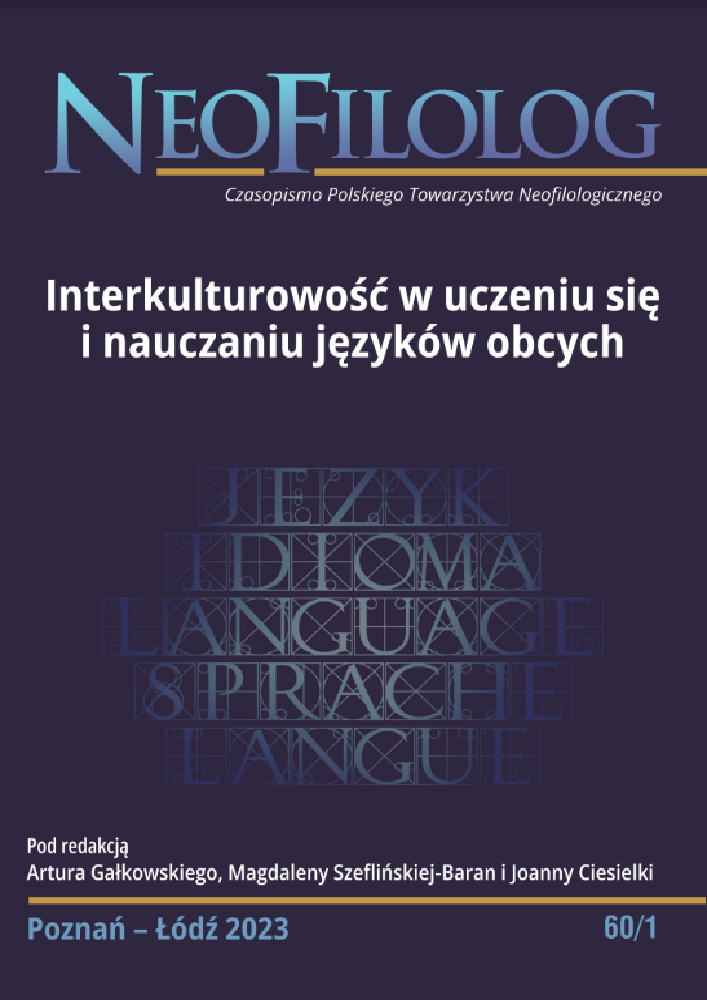Abstract
Didactic translations and translation projects are one of the ways of familiarising students simultaneously with a foreign language and culture, allowing them to develop language competences and learn about cultural similarities and differences. The aim of this article is to present a way of acquainting students with elements of foreign culture through translation, show the benefits of working with translation for language learning and present difficulties related to the translation of cultural elements and solutions used by translators. Teaching language and culture through translation has many advantages. First of all, working with the original text gives students access to the elements of the source culture in a specific communication context. Moreover, the translation assumes an in-depth understanding of the original, including intercultural allusions and intertextual references. The effort put into the translation process by the students makes them better memorize foreign elements and structures.
Literaturhinweise
Andresen de Mello Breyner S. (1996), Contos exemplares. Porto: Figueirinhas.
Andresen de Mello Breyner S. (2018), Opowiadania przykładne. Lublin: Wydawnictwo UMCS.
Banach B. (2001), Interkulturowa tendencja we współczesnej glottodydaktyce, (w:) Habrajska G. (red.), Język w komunikacji. t.3. Łódź: Wydawnictwo Wyższej Szkoły Humanistyczno-Ekonomicznej, s. 228–242.
Bennett M. (1998), Intercultural Communication: A Current Perspective, (w:) Bennett M. (red.), Basic Concepts of Intercultural Communication. Yarmouth: Intercultural Press, s. 1–34. DOI: https://doi.org/10.1002/9781118783665.ieicc0178
Berman A. (2009), Przekład jako doświadczenie obcego, (w:) Bukowski P., Heydel M. (red.), Współczesne teorie przekładu. Kraków: Znak, s. 249–264.
Byram M. (1997), Teaching and Assessing Intercultural Communicative Competence. Clevedon: Multilingual Matters.
Dunin-Dudkowska A. (2011), Tłumaczenia dydaktyczne w nauce języka polskiego jako obcego. „Acta Universitatis Lodziensis. Kształcenie Polonistyczne Cudzoziemców”, nr 18, s. 387–392.
Giczela-Pastwa J., Biel Ł. (2021), Kooperacyjne uczenie się przekładu – 15 lat działalności Studenckiego Koła Naukowego Przekładu Specjalistycznego LINGUANA, (w:) Kubińska O., Kuniński W., Kur M. (red.), Dydaktyka przekładu. Nauczanie przez projekty. Gdańsk: Wydawnictwo Uniwersytetu Gdańskiego, s. 79–98.
Grucza F. (1979), Metody, techniki i ćwiczenia glottodydaktyczne, (w:) Grucza F. (red.), Polska myśl glottodydaktyczna 1945-1975. Wybór artykułów z zakresu glottodydaktyki ogólnej. Warszawa: PWN, s. 314–326.
Hinc J., Jarosz A. (2019), Tłumaczenia dydaktyczne w nauczaniu języka obcego – przykłady ćwiczeń na zdania warunkowe, (w:) Grabowska M., Hinc J., Jarosz A., Mampe J. (red.), Translatoryka i glottodydaktyka. Od teorii do praktyki. Gdańsk: Wydawnictwo Uniwersytetu Gdańskiego, s. 201–214.
Janowska I. (2015), Kompetencja komunikacyjna a glottodydaktyka, „LingVaria”, nr. 2, s. 41–54. DOI: https://doi.org/10.12797/LV.10.2015.20.04
Komorowska, H. (1996). Nowe tendencje w pracach programowych Rady Europy. Koncepcja celów nauczania języków obcych, „Języki Obce w Szkole”, nr 2, s. 109–115.
Komorowska H. (1999), Metodyka nauczania języków obcych. Warszawa: WSiP.
Lefevere A. (1992), Translation, Rewriting and the Manipulation of Literary Fame. Londyn i Nowy Jork: Routledge.
Lewicki R. (2002), Obcość w przekładzie a obcość w kulturze, (w:) Lewicki R. (red.), Przekład. Język. Kultura. Lublin: UMCS, s. 43–51.
Lipińska E., Seretny A. (2016), Tłumaczenie w nauczaniu/uczeniu się języka obcego – od słowa do tekstu, (w:) Lipińska E., Seretny A. (red.), Tłumaczenie dydaktyczne w nowoczesnym kształceniu językowym. Kraków: Księgarnia Akademicka, s. 23–35.
Nagórko A. (2004), Metody konfrontatywne a etnolingwistyka (lingwistyka kulturowa), (w:) Flórián E. (red.), Wielokulturowość, tożsamość narodowa, mniejszości na Węgrzech i w Polsce: język, literatura, kultura. Debreczyn: Kossuth Egyetemi K., s. 25-33.
Newmark P. (1988), Approaches to Translation. Hertfordshire: Prentice Hall.
Tomaszkiewicz T. (2006), Terminologia tłumaczenia. Poznań: UAM.
Toury G. (2000), The nature and role of norms in translation, (w:) Venuti L. (red.), The Translation Studies Reader. Londyn i Nowy York: Routledge, s. 199–211.
Venuti L. (2009), Przekład, wspólnota, utopia, (w:) P. Bukowski, M. Heydel (red.), Współczesne teorie przekładu. Kraków: Wydawnictwo Znak, s. 267–293.
Żydek-Bednarczuk U. (2012), Kompetencja międzykulturowa w nauczaniu języka polskiego jako obcego. „Postscriptum Polonistyczne”, nr 2 (10), s. 19–30.
Lizenz
Copyright (c) 2023 Agnieszka Kruk

Dieses Werk steht unter der Lizenz Creative Commons Namensnennung - Keine Bearbeitungen 4.0 International.
Autoren:
Die Autoren der zur Veröffentlichung in der Zeitschrift Neofilolog angenommenen Texte sind verpflichtet, den Vertrag über die Erteilung einer kostenlosen Lizenz für die Werke mit der Verpflichtung zur Erteilung einer Sublizenz CC auszufüllen, zu unterzeichnen und an die Adresse der Redaktion zurückzusenden.
Gemäß Vertrag erteilen die Autoren auf die in der Zeitschrift Neofilolog veröffentlichten Texte der Adam-Mickiewicz-Universität in Poznań eine nicht exklusive und kostenlose Lizenz und erlauben die Verwendung der Sublizenz Creative Commons Attribution-NoDerivatives 4.0 International (CC BY-ND 4.0).
Die Autoren behalten das Recht zur weiteren freien Verfügung über das Werk.
Benutzer:
Interessierte Onlinebenutzer dürfen die seit 2017 veröffentlichten Werke unter folgenden Bedingungen nutzen:
- Anerkennung der Urheberschaft - die Verpflichtung, zusammen mit dem verbreiteten Werk Informationen über die Urheberschaft, den Titel, die Quelle (Links zum Originalwerk, DOI) und die Lizenz selbst bereitzustellen;
- ohne Schaffung abgeleiteter Werke - das Werk muss in seiner ursprünglichen Form erhalten bleiben, ohne Zustimmung des Autors dürfen keine Studien, beispielsweise Übersetzungen, verbreitet werden.
Die Urheberrechte aller veröffentlichen Texte sind vorbehalten.
Sonstige:
Die Adam-Mickiewicz-Universität in Poznań behält das Recht auf die Zeitschrift als Gesamtheit (Layout, Grafik, Titel, Umschlagsprojekt, Logo usw.).

